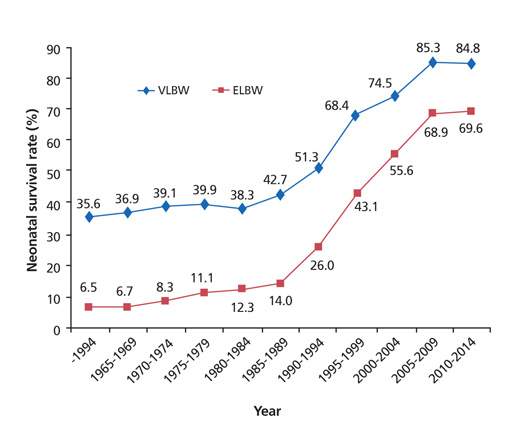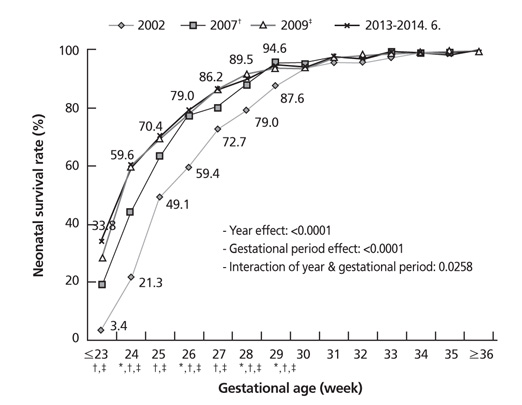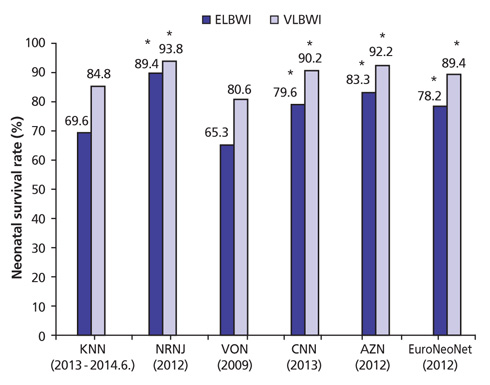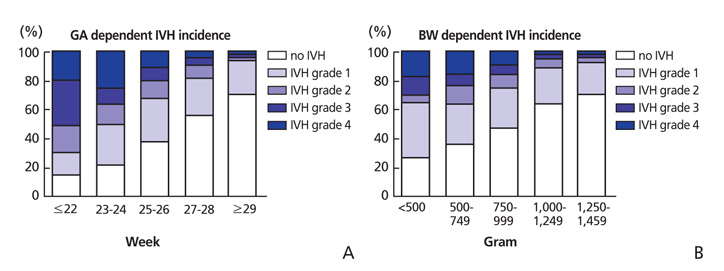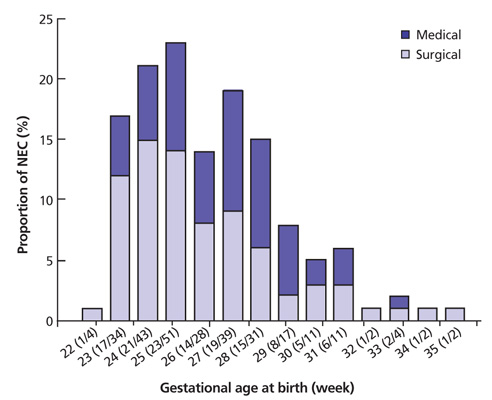J Korean Med Assoc.
2016 Jul;59(7):498-505. 10.5124/jkma.2016.59.7.498.
Changes in neonatal outcomes in Korea
- Affiliations
-
- 1Department of Pediatrics, Yeouido St. Mary's Hospital, The Catholic University of Korea School of Medicine, Seoul, Korea. sykimped@catholic.ac.kr
- KMID: 2343860
- DOI: http://doi.org/10.5124/jkma.2016.59.7.498
Abstract
- In Korea, the first neonatal intensive care unit was established in the early 1980s, and over the past 30 years, the advancements in the field of neonatology in Korea have led to a significant improvement in the survival of low birth weight infants. The survival rates of very low birth weight infants (VLBWIs) more than doubled, from 38.3% in the 1980s to 84.8% in 2014, and the survival rates of extremely low birth weight infants increased more than five-fold, from 12.3% in the 1980s to 69.6% currently. A comparison of VLBWI survival among countries showed improved survival rates in each birth weight group in Canada, Australia-New Zealand, and various European countries, with Japan at the top. For the first time in Korea, a nationwide prospective web-based registration system for VLBWIs, the Korean Neonatal Network (KNN), was established, and KNN operations were initiated officially on April 15, 2013 by the Korean Society of Neonatology with support from the Korea Centers for Disease Control and Prevention. As of April 2016, clinical data for over 6,700 VLBWIs have been collected from 64 participating hospitals across the country. This network has made it possible to investigate overall survival rates as well as short- and long-term outcomes in VLBWIs. The purpose of this review was to evaluate the recent changes in neonatal outcomes in VLBWIs in Korea based on KNN data.
Keyword
MeSH Terms
Figure
Cited by 1 articles
-
Past, present, and future of neonatology in Korea
Yun Sil Chang
J Korean Med Assoc. 2016;59(7):487-489. doi: 10.5124/jkma.2016.59.7.487.
Reference
-
1. Bae YM, Bae CW. The changes in the mortality rates of low birth weight infant and very low birth weight infant in Korea over the past 40 years. J Korean Med Sci. 2004; 19:27–31.
Article2. Hahn WH, Chang JY, Chang YS, Shim KS, Bae CW. Recent trends in neonatal mortality in very low birth weight Korean infants: in comparison with Japan and the USA. J Korean Med Sci. 2011; 26:467–473.
Article3. Shim JW, Jin HS, Bae CW. Changes in survival rate for verylow- birth-weight infants in Korea: comparison with other countries. J Korean Med Sci. 2015; 30:Suppl 1. S25–S34.4. Cho JH, Choi SK, Chung SH, Choi YS, Bae CW. Changes in neonatal and perinatal vital statistics during last 5 decades in Republic of Korea: compared with OECD nations. Neonatal Med. 2013; 20:402–412.
Article5. Chang JY, Lee KS, Hahn WH, Chung SH, Choi YS, Shim KS, Bae CW. Decreasing trends of neonatal and infant mortality rates in Korea: compared with Japan, USA, and OECD nations. J Korean Med Sci. 2011; 26:1115–1123.
Article6. Kim TH, Choi MS, Chung SH, Choi YS, Bae CW. Morbidity of low birth weight infants in Korea (2012): a comparison with Japan and the USA. Neonatal Med. 2014; 21:218–223.
Article7. Chang YS, Ahn SY, Park WS. The establishment of the Korean Neonatal Network (KNN). Neonatal Med. 2013; 20:169–178.
Article8. Chang YS, Park HY, Park WS. The Korean Neonatal Network: an overview. J Korean Med Sci. 2015; 30:Suppl 1. S3–S11.
Article9. Park DK, Kil CH, Bae CW. Neonatal statistics of Korea in 2002: collective results of live-births, and neonatal mortality rates from 62 hospitals. J Korean Soc Neonatol. 2004; 11:122–129.10. Hahn WH, Chang JY, Bae CW. Birth statistics and mortality rates for neonatal intensive care units in Korea during 2007: collective results from 57 hospitals. J Korean Soc Neonatol. 2009; 16:36–47.11. Kim KS, Bae CW. Trends in survival rate for very low birth weight infants and extremely low birth weight infants in Korea, 1967-2007. Korean J Pediatr. 2008; 51:237–242.
Article12. Neonatal Research Network. Neonatal Research Network Japan [Internet]. place unknown: Neonatal Research Network;cited 2015 April 20. Available from: http://nrn.shiga-med.ac.jp/Englishdefault.htm.13. The Canadian Neonatal Network. CNN 2013 annual report; birth weight and survival to discharge [Internet]. Toronto: The Canadian Neonatal Network;2013. cited 2015 April 20. Available from: http://www.canadianneonatalnetwork.org/portal/.14. National Perinatal Epidemiology and Statistics Unit (NPESU). Australian and New Zealand Neonatal Network (ANZNN) [Internet]. Sydney: National Perinatal Epidemiology and Statistics Unit (NPESU);2013. cited 2015 April 20. Available from: https://npesu.unsw.edu.au/data-collection/australian-newzealand-neonatal-network-anznn.15. European Neonatal Network. EuroNeoNet: annual report for VLGAI 2012 cohort general description [Internet]. place unknown: European Neonatal Network;cited 2015 April 20. Available from: http://www.euroneonet.eu/paginas/publicas/euroneo/euroNeoNet/index.html.16. Lim JW, Chung SH, Kang DR, Kim CR. Risk factors for causespecific mortality of very-low-birth-weight infants in the Korean neonatal network. J Korean Med Sci. 2015; 30:Suppl 1. S35–S44.
Article17. Choi JS, Bae CW, Chang YS, Lee NH, Hong WR. Policy issues on neonatal intensive care for low birth weight infants. Seoul: Korea Institute for Health and Social Affairs;2012.18. Choi CW, Kim BI, Kim EK, Song ES, Lee JJ. Incidence of bronchopulmonary dysplasia in Korea. J Korean Med Sci. 2012; 27:914–921.
Article19. Jo HS, Cho KH, Cho SI, Song ES, Kim BI. Recent changes inthe incidence of bronchopulmonary dysplasia among very-lowbirth- weight infants in Korea. J Korean Med Sci. 2015; 30:Suppl 1. S81–S87.20. Ahn SY, Shim SY, Sung IK. Intraventricular hemorrhage and post hemorrhagic hydrocephalus among very-low-birth-weight infants in Korea. J Korean Med Sci. 2015; 30:Suppl 1. S52–S58.
Article21. Lee JA, Kim MJ, Oh S, Choi BM. Current status of therapeutic strategies for patent ductus arteriosus in very-low-birth-weight infants in Korea. J Korean Med Sci. 2015; 30:Suppl 1. S59–S66.
Article22. Lee SM, Chang M, Kim KS. Blood culture proven early onset sepsis and late onset sepsis in very-low-birth-weight infants in Korea. J Korean Med Sci. 2015; 30:Suppl 1. S67–S74.
Article23. Youn YA, Kim EK, Kim SY. Necrotizing enterocolitis among very-low-birth-weight infants in Korea. J Korean Med Sci. 2015; 30:Suppl 1. S75–S80.
Article24. Hwang JH, Lee EH, Kim EA. Retinopathy of prematurity among very-low-birth-weight infants in Korea: incidence, treatment, and risk factors. J Korean Med Sci. 2015; 30:Suppl 1. S88–S94.
Article25. Korean Statistical Information Service. Birth statistics [Internet]. Daejeon: Korean Statistical Information Service;2016. cited 2016 April 20. Available from: http://www.kosis.kr/.26. Moon JY, Hahn WH, Shim KS, Chang JY, Bae CW. Changes of maternal age distribution in live births and incidence of low birth weight infants in advanced maternal age group in Korea. Korean J Perinatol. 2011; 22:30–36.27. Choi SH, Park YS, Shim KS, Choi YS, Chang JY, Hahn WH, Bae CW. Recent trends in the incidence of multiple births and its consequences on perinatal problems in Korea. J Korean Med Sci. 2010; 25:1191–1196.
Article
- Full Text Links
- Actions
-
Cited
- CITED
-
- Close
- Share
- Similar articles
-
- Neonatal seizures in Korea, 1983-2009
- Risk of Emergency Operations, Adverse Maternal and Neonatal Outcomes according to the Planned Gestational Age for Cesarean Delivery
- The effects of epidural analgesia on maternal fever and neonatal outcomes
- Quality Improvement in Neonatal Intensive Care Units
- Changes in Neonatal Epidemiology during the Last 3 Decades in Korea

